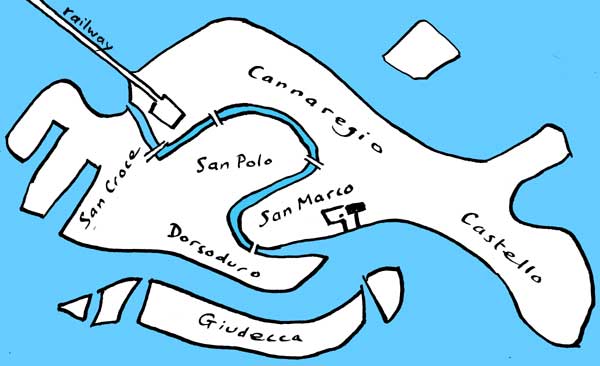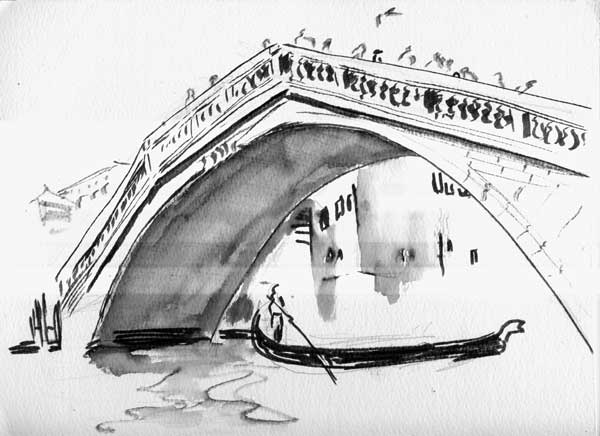|
Venice as maze
We say easily that some place feels “maze-like“, but
Venice really does. Like those other towns, it's not topologically
a maze, in the sense of having ways that spiral in on themselves
or wrap around each other or lead a long way to nowhere, but it
feels like a maze in that you just cannot find your way across it
by taking direct routes. There are no direct routes.
There is just one large simple form,
the Z (really a smooth backward S) of the Grand Canal. It serves
to divide the island city into describable pieces: San Polo and
San Marco within the two curves, Cannaregio and Castello and Dorsoduro
and San Croce around (though these pieces do not at all closely
correspond to the mazy boundaries of the six traditional sestieri
with the same names). To link the regions, there are only the three
bridges — Scalzi, Rialto, Accademia — across the Z of the
Grand Canal. (This was before the recent building of a western steel
bridge at the Piazzale Roma.) To get expeditiously between points
far apart, the only way is to go by vaporetto, water bus,
along the Grand Canal. On land there are very few ways that continue
more or less unbroken for distances more than a hundred yards: the
Strada Nuova in Cannaregio, and some fondamente along canal
sides. Even these are interrupted, like every other way, by the
stepped humps of the bridges over the small canals.

(There are no wheeled vehicles in Venice,
except handcarts, and tourists' wheeled luggage. Not quite true
since Mussolini built the long bridge that carries the railway and
also a road into the industrial northwest corner of the city. Even
bicycles aren't supposed to be allowed, though one shows furtively
in a painting I did on my first visit to Venice.)
Every other street or passageway is
in short bits, which rapidly debouch into cross-bits, unless they
turn corners, open into campi, or dead-end into walls or
into canals. (I have come very close to stepping off a passageway's
end into a canal.) The buildings are rectangular or nearly so, and
line up along the Grand Canal or some of the sides of campi,
but they have been shaken together in a centuries-long sieve. The
mass of buildings and slits between them gradually shifts orientations,
so that it's no use trying to keep your continual left and right
turns to a general direction; your general direction curves, and
sometimes comes around in a circle. If you ask directions to somewhere
you get a pointed finger and “sempre diritto” —
but there is no diritto in Venice!
The only way, if you don't know the
way, is to discern a crowd and follow it. Here and there, even late
at night, you come across a thickening of people, very much like
ants who know they are on a trail because they keep bumping into
their fellows. They are going one way toward San Marco and the other
way toward the station (the Rialto being the mid point between them
through which most journeys have to go). So you guess left or right
and follow them; and because of the ant-trail you know not to stay
with, for instance, the relatively wide and straight Calle dei Botteri
but to turn into one of the slits in its side.
Someone born in Venice and going to
another city may find its blocks or wedges of streets crassly simple.
A Venetian could surely not get lost in any other city! We might
find that Venetians are winners at maze-solving.
Helpfully to tourists the municipality
has put up many arrowed signs along the ant-trails:
<— SAN MARCO RIALTO— > STAZIONE—
>
On one wall near the Santi Apostoli, signs point toward the very
remote STAZIONEin opposite directions!
And the canals — that is, the
small ones, called rii. Before going to Venice I imagined
it to be a number of islands, with a sort of village sitting on
each and looking out across its surrounding bridges. Well, there
may once have been on each island its village, which grew outward
to fit against the surrounding water and narrow it to a canal; but
it doesn't appear like that, except that there are the campi
or “squares“, many of which still feel like the hubs of
villages. You are aware mostly of the mass of stone, finding your
way around inside it — turning corners, passing between pillars
and under arches and around the rambling limbs of churches —
and at unexpected moments you come across a piece of a canal, like
a bit of broken glass glittering among bricks.
The bridges — all high semicircular
humps of white stone to let standing gondoliers pass under, with
seven to ten steps up each side — are themselves, some of them,
like little villages with room to congregate: because the openings
they connect may not be opposite to each other, and may be more
than one to each side. I think the most spacious, and almost impossible
to draw the plan of while standing on it, is the one that evolved
to get from San Giovanni Crisostomo to the Campo Flaminio Corner
north of it.
There is a fine large map that you
can buy; it appears to show, in pleasant color, the shape of every
block of buildings, every alley and courtyard. This map, though
it has only a few mistakes (Campo Santa Maria Nova has an extension
because a building is missing), compounds the maze. The map may
give street-names that it considers correct though people no longer
use them, the street signs may give dialectal forms — or vice
versa. We were directed to the street called La Merceria; but that
name applies on the map to one street, in reality to a group of
several little streets roughly alongside each other like tines of
a fork; the signs posted on them say (for instance) Marzaria del
San Salvador o de Capitello; the map gives them yet other names.
You come to a sign that says: Ponte Giovanni Andrea de la Croce
o de la Malvasia. Can you remember that? — and how do you parse
it, is “de la Malvasia” the alternative name of Giovanni
or of the bridge?
On the map it may appear that the
route you want to take — even one of the main ant-trail routes
— does not get through at all; or that there is no way to get
to one of the landing-places of vaporetto or traghetto
on the Grand Canal's sides. If you look at the map more closely,
there are little dashed lines: there is a way under the buildings,
a sottoportego.
I recognized the view I had so elaborately
drawn during my first visit to Venice long ago: we were on the Ponte
de Bareteri, looking along a short stretch of canal to where it
runs into another at a T. Tilly saw among the windows in the farther
wall of the crossing canal a “Camere” sign; wouldn't it
be good to lodge at this spot, in my painting? and she set off to
inquire at the place, which seemed not far away. As soon as I, left
on the bridge, looked at the map, I knew I shouldn't have let her
go. It wasn't totally impossible to get to the other side of that
building from here, but it involved a detour of seven times the
distance, false turnings to avoid, another bridge, garden gates
— I knew she'd be lost. She was, and I could only wait for her
to find her way back.
The campo that feels most like
a village, somewhere in the San Polo region, is San Giacomo dell'Orio
(one of the less easy names to recall in a hurry!). It's an ample
space because it wraps around its church, which is externally a
rambling dusty heap of round apses and has the usual art to boast
of inside. There are trees, benches, a shop, café tables; dogs,
birds, and people hang out; drifts of children cross on their way
from school, and play with balls and skateboards. One of the openings
piercing the smoother of the two long sides happens to be that leading
to Venice — to mainer parts; the others prove to be tunnels
ending in wharves on a canal. On the other long side, one of the
ways around the church leads (past the opening of a hidden courtyard)
to a sub-campo beside another canal, with more tables and a bridge;
two others lead to two other bridges, which can see but not communicate
with each other. The tapering end of the campo (Calle Larga,
though not at all wide) becomes a sort of grotto easier to draw
than concisely describe: yet another canal, turning a corner, the
usual humped bridge with chain of figures loitering or hurrying
over it, restaurant tables crowding points on either side, alley-streets
slipping away slit-like to three destinations.
There are, in the cores of other old
cities, similarly dense webs of alleys and piazzas and perhaps even
canal-glimpses, but the web of Venice is vast. It's all core. Just
glancing at the map, or opening a guide-book and seeing all the
chapters on the component districts, you are impressed by its vastness.
It extends over almost the whole main island, that is, the island-mass,
as much as — well, on measuring it I find it's only about a
mile and a half wide. It seems several times wider, presumably because
walking across it is such an intricate labor. That's why, though
Venice is now injected with ridiculously large hordes of tourists,
they don't seem dominant except in their concentrations around the
station, Rialto, and San Marco. The mass absorbs them, like particles
in the passages of a lung.
Venice is — to under-state —
pleasant to arrive at. You cross the lagoon in the train, come out
of the broad front of the station; broad steps descend to the bank
of the Grand Canal, at left is the Ponte dei Scalzi (“of the
barefoots”); you ascend it and descend into the maze. I conceived
of making a Venice Maze Game: you find yourself in a little street
that leads straight ahead, in the general direction of Venice's
heart, you quickly come to a point where there is a turning you
could take to the left, but you ignore it and go ahead — and
the little street dead-ends. You have to go back and take that other
turning, over a canal, and so it goes on.

Ponte Scalzi
Back
|


